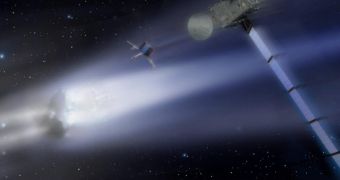Europe's comet chaser, the Rosetta spacecraft, was powered up last week in anticipation for the fly-by around asteroid 2867 Steins scheduled to take place on September 5th, 2008. Rosetta was originally designed and launched in order to approach and study the comet 67P/Churyumov-Gerasimenko, with which the spacecraft will meet somewhere around the first half of 2014.
Rosetta was launched into space by the European Space Agency in 2004 and was kept in a hibernation stage, periodically interrupted by events such as scheduled fly-bys around Earth or other bodies orbiting inside the solar system, such as comets and asteroids. In March 2005, Rosetta made its first fly-by around Earth followed, nearly two years later, by a tour around the Red Planet. In November last year, Rosetta made its second fly-by around Earth and was again placed in hibernation.
Until now that is, when the probe was again awaken to begin the preparations for its encounter with the 2867 Steins, a main belt asteroid discovered in 1967, measuring approximately 4.6 kilometers across. Initial data relayed by Rosetta revealed that asteroid Steins had no moon and executed a complete revolution about its axis in approximately six hours. It is catalogued as an E-type asteroid, meaning that its surface is covered with enstatite achondrite. Most E-type asteroids are small in size and make for up to 60 percent of the bodies inward of the main asteroid belt, although their concentration decreases sharply in the main belt proper.
What's curious about E-type asteroids in that although they contain roughly the same materials our planet is made of, silicates and basalts, they are amongst the rarest asteroid types in the solar system. During its approach, Rosetta will come as close as 800 kilometers from Steins, in order to study more closely its composition, rotation and the effects produced by charged particles in the solar wind while interacting with it.
However, until then, Rosetta still has a lot of preparations to go through. Once the observations on the Steins asteroid are completed, the spacecraft will again be put to 'sleep' until its third and final fly-by around Earth in 2009. In 2010, Rosetta will approach asteroid Lutetia and will enter the four year deep hibernation stage before the encounter with 67P/Churyumov-Gerasimenko. By that time, ESA's robotic mission will have covered a distance of 6.5 billion kilometers.

 14 DAY TRIAL //
14 DAY TRIAL //